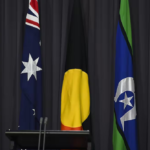The intervention versus homelands – shattered ambitions
Homelands began in the 1960s in a political climate of increasing recognition of Indigenous rights and progressive reform. Brendan Howden says homelands offer a more successful and sustainable way forward for remote area Aboriginal people than the intervention model.
In essence this is the story of a dispossessed and marginalised people reclaiming their country, culture and lives versus a state and culture hell bent on making them over in their own image.
The shifting fate of Aboriginal homelands in the Northern Territory (NT) has never been more tenuous. Now in the hands of a conservative Territory government that has lost the faith of three of its four remote areas Aboriginal members, it seems perilous. This same government saw fit to allocate only $7 million toward housing on homelands where 30% of the NT’s Aboriginal population live. Contrast the designated community ‘growth towns’, home to 24% of the NT’s Aboriginal people, with $672 million federally and a further $100 million from the NT government for housing. Do the math and it equates to 133:1, odds stacked in these communities’ favour. It begs the question how did we get to this state of affairs?
Homelands began in the late 1960’s, Australia finally recognising the failure of its assimilationist practices and succumbing to the International community’s moral pressure. In a political climate of increasing recognition of Indigenous rights and progressive reform many Aboriginal people were supported in their desire to get back to ‘country and culture’ away from communities constructed by governments and missionaries for their assimilation. These communities hold deep scars for many Aboriginal people, histories of stolen children, forced labour, loss of language and culture, abuse and disempowerment. They are also someone else’s ‘country’, land belongs to the traditional owners not the people forced there, a fact mostly ignored by governments but a very current and contentious issue for Aboriginal people.
Sadly little is known of the success stories of homelands, most Australians never get to experience them first hand. For many they are places of mystique and the colonialist myth of real Aboriginals, ‘the noble savage’. Remote Aboriginal people still carry the burden of this curiosity, something pristine to be preserved in a fixed state but also backward and dangerous. In reality homelands are varied, from budding remote tourist villages with English as the only language to enclaves immersed in traditional language, culture and subsistence. It matters not what form they take but that they are a reflection of the people who inhabit them and their ambitions.
Why, because they generally work. Even against a backdrop of limited services and resistance to their establishment they have been shown to produce better health, well-being and social harmony outcomes than the larger remote communities. They also offer more sustainable employment opportunities through tourism, arts, land management and natural resources harvesting. Yes, there are issues of health, services, education, housing and employment to be invested in but, offered the opportunity and resources with direct input into decisions affecting their places and lives, homelands showcase the capacity and willingness for remote Aboriginal people to take care of themselves.
Unfortunately current conservative Commonwealth and Territory governments, with neo-liberal principles, coincide with the legacy of John Howard’s NT Intervention, ‘Closing The Gap in the Northern Territory’ implemented by the intervening Labor government. The Intervention was introduced with emotive language of ‘national crisis’ and ‘national emergency response’ to rampant paedophilia and extreme child abuse persuading the majority of Australians to accept swift policy passage that was fundamentally racist. Despite intensive government health checks and police investigations these claims have never been substantiated. What they have done is stigmatise remote Aboriginal men and belittle their status as fathers, uncles, colleagues and friends, further marginalising them. The Intervention has stymied the progress of homelands and returned Australia to a paternalistic past.
Commentators such as Gary Johns with his recent article in The Australian only serve to confuse the issue and continue paternalistic concepts that present only one possible pathway to success, assimilation. The ongoing notion of ‘we know best’ sees 15 remote communities selected to receive nearly all targeted government funds for development of remote Aboriginal services in the NT. Communities with the aforementioned tragic histories, ongoing conflicts of ownership and governance and less opportunity for employment than forty years ago, which have become largely dysfunctional. The abandonment of Aboriginal homelands is serving assimilationist and neo-liberal agendas.
Western enculturation is served by bringing more white people in positions of power into these developing hubs to provide services to a disempowered people further alienated from their land, language, culture and ambitions. The positions of power and status are only reinforced in this environment in the everyday social interactions: white people have power, white people work, white people have the right education and skills, and black people do not.
Centralisation is pretexted on the ‘efficiencies’ of economies of scale, a flawed arrangement given differential health and social outcomes already noted which will add substantial cost as people are forced to relocate from their homelands. However these economies of scale do serve the interests of big business, enabling large-scale contracts to be established within a more easily defined and controlled environment, the capitalist dream. Nothing here to serve the ambitions of remote Aboriginal people themselves who, once again, were not even invited to the table when the Remote Service Delivery plans were drawn up.
The real issue here is not that there is no alternative, rather that the alternative does not fit the Western capitalist construct. Homelands offer a healthier, more successful and sustainable way forward for remote area Aboriginal people. While some may choose a predominantly Western lifestyle as many Aboriginal people now do in our cities, it is their choice to make not ours. Under our agreement to the United Nations Declaration on the Rights of Indigenous Peoples we have obligation to include Aboriginal people in decision making and obtain free, prior and informed consent before adopting laws and policies that affect them. Perhaps it is time we revisited our notions of national pride in the world community. Recognition of Indigenous people’s rights may be a good place to start by leaving a paternalistic past as something for which we are truly sorry.
Brendan Howden was born in Broome, WA, later growing up in Mildura, Victoria. As an adult he moved to Darwin and worked in training and education. Currently he lives in Kempsey, NSW, working in education and studying a Bachelor of Social Work with Charles Sturt University. From his early life experiences and later work in education Brendan has a passion for working together with Aboriginal people to improve educational engagement and practices for Aboriginal children.













